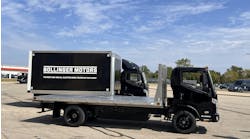Recent headlines from Iraq, Libya and Syria are unsettlingly familiar: political unrest in major petroleum-producing regions continues to sustain high fuel prices and volatility. Despite the recent U.S. energy supply boom, the Energy Information Administration (EIA) reports that the U.S is still importing 7 million barrels of oil per day, or 40% of its daily consumption. The transportation industry consumes more oil than any other sector, with 3.5 million barrels of oil per day being consumed by the nation’s fleet of over-the-road trucks alone.
The good news is the U.S. is already on the right path to changing this outlook. Domestic energy production is forecasted to thrive in the years ahead, with the EIA predicting oil imports to decrease from 40% to a mere 22% of U.S. consumption by the end of 2015. Given the forecast, one might ask, “Is the drive to curb our oil consumption no longer as critical as it was before our domestic supply boom?”
Quite the opposite. In spite of our historic U.S. oil production rates, oil prices are set on a global basis. As long as America is tied to using crude oil to fuel its movement of goods via diesel-powered trucks, ships and locomotives, our transportation sector will largely remain at the mercy of the global, and often tumultuous, oil market. Further, while we have seen a positive surge in domestic oil production in the Dakotas and South Texas, the light sweet crude being produced is not well-suited for most U.S. refineries which have been optimized to process the heavier crudes imported from places like Venezuela, Nigeria and the Middle East. Lastly, many analysts agree that at prices in the $70-per-barrel range, it became uneconomical to produce oil from the shale plays in South Texas, North Dakota and elsewhere. In short, it looks like we are in for much of the same for the foreseeable future; thus continuing the drive for alternative fuels, efficiency improvement strategies and other ways to reduce a fleet’s fuel and operating costs.
So what should fleet operators do?
To start, expand your business connections and knowledge of alternative fuels and advanced transportation technologies by participating in conferences, such as the Alternative Clean Transportation Expo, that facilitate peer-to-peer learning and networking.
By learning from early adopters, you can evaluate the opportunity to implement the multiple alternative fuels options available that have lower emissions and can provide significant cost savings. Clients of ours are reporting net cost reductions of $0.20/mi. to $0.30/mi. and two year or less payback periods using alternative fuels.
You can also get involved with your local Clean Cities coalition to tap into expert advice on funding and strategies, and meet fleets in your local area that have similar needs and goals.
There is no “one size fits all” approach. Alternative fuels, efficiency improvement technologies, and other strategies will all play a vital role in moderating the continued high and volatile price of diesel and gaining important environmental benefits. The question then becomes: when will you start to reduce your costs and emissions?
Erik Neandross is CEO of Gladstein, Neandross & Associates (GNA), the clean transportation and energy consulting firm that organizes the Alternative Clean Transportation (ACT) Expo. Learn more at www.gladstein.org and www.actexpo.com.



